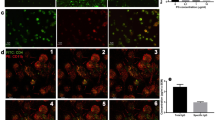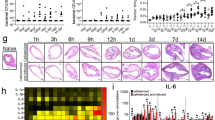Abstract
Implantation of bacteria embedded in a fibrin clot allows for successful establishment of sepsis in preclinical models. This model allows the investigator to modulate the strain of bacteria as well as the bacterial load delivered. As it allows for a slow release of standardized bacteria, the use of a fibrin clot model may be considered in studying the initial and later phases of sepsis and the host response to infection. Here we describe methods for performing the fibrin clot model of sepsis.
Access this chapter
Tax calculation will be finalised at checkout
Purchases are for personal use only
Similar content being viewed by others
References
Angus DC, Linde-Zwirble WT, Lidicker J et al (2001) Epidemiology of severe sepsis in the United States: analysis of incidence, outcome, and associated costs of care. Crit Care Med 29:1303–1310
Annane D, Bellissant E, Cavaillon JM (2005) Septic shock. Lancet 35:63–78
Martin GS, Mannino DM, Eaton S et al (2003) The epidemiology of sepsis in the United States from 1979 through 2000. N Engl J Med 348:1546–1554
Pinsky MR (2001) Sepsis: a pro- and anti-inflammatory disequilibrium syndrome. Contrib Nephrol 132:354–366
Hotchkiss RS, Nicholson DW (2006) Apoptosis and caspases regulate death and inflammation in sepsis. Nat Rev Immunol 6:813–821
Weber SU, Schewe JC, Lehmann LE et al (2008) Induction of Bim and Bid gene expression during accelerated apoptosis in severe sepsis. Crit Care Med 12:R128
Stortz JA, Raymond SL, Mira JC et al (2017) Murine models of sepsis and trauma: can we bridge the gap? ILAR J 58:90–105
Buras JA, Holzmann B, Sitkovsky M (2005) Animal models of sepsis: setting the stage. Nat Rev Drug Discov 4:854–865
Piper RD, Cook DJ, Bone RC et al (1996) Introducing critical appraisal to studies of animal models investigating novel therapies in sepsis. Crit Care Med 24:2059–2070
Poli-de-Figueiredo LF, Garrido AG, Nakagawa N et al (2008) Experimental models of sepsis and their clinical relevance. Shock 30(Suppl 1):53–59
Lewis AJ, Seymour CW, Rosengart MR (2016) Current murine models of Sepsis. Surg Infect 17:385–393
Ahrenholz DH, Simmons RL (1980) Fibrin in peritonitis. I. Beneficial and adverse effects of fibrin in experimental E. coli peritonitis. Surgery 88:41–47
Mathiak G, Szewczyk D, Abdullah F et al (2000) An improved clinically relevant sepsis model in the conscious rat. Crit Care Med 28:1947–1952
Natanson C, Fink MP, Ballantyne HK et al (1986) Gram-negative bacteremia produces both severe systolic and diastolic cardiac dysfunction in a canine model that simulates human septic shock. J Clin Invest 78:259–270
Baron RM, Kwon MY, Castano AP et al (2018) Frontline science: targeted expression of a dominant-negative high mobility group A1 transgene improves outcome in sepsis. J Leukoc Biol 104:677–689
Chung SW, Liu X, Macias AA et al (2008) Heme oxygenase-1-derived carbon monoxide enhances the host defense response to microbial sepsis in mice. J Clin Invest 118:239–247
Toky V, Sharma S, Arora BB et al (2003) Establishment of a sepsis model following implantation of Klebsiella pneumoniae-infected fibrin clot into the peritoneal cavity of mice. Folia Microbiol 48:665–669
Tsoyi K, Hall SR, Dalli J et al (2016) Carbon monoxide improves efficacy of mesenchymal stromal cells during sepsis by production of specialized proresolving lipid mediators. Crit Care Med 44(12):e1236–e1245
Zellweger R, Wichmann MW, Ayala A et al (1997) Females in proestrus state maintain splenic immune functions and tolerate sepsis better than males. Crit Care Med 25:106–110
Acknowledgments
This work was supported by the National Institutes of Health grants K08GM126313 (to Dr. Ghanta) and R01GM118456 (to Dr. Perrella).
Author information
Authors and Affiliations
Corresponding author
Editor information
Editors and Affiliations
Rights and permissions
Copyright information
© 2021 Springer Science+Business Media, LLC, part of Springer Nature
About this protocol
Cite this protocol
Ghanta, S., Kwon, MY., Perrella, M.A. (2021). Induction of Sepsis Via Fibrin Clot Implantation. In: Walker, W.E. (eds) Sepsis. Methods in Molecular Biology, vol 2321. Humana, New York, NY. https://doi.org/10.1007/978-1-0716-1488-4_3
Download citation
DOI: https://doi.org/10.1007/978-1-0716-1488-4_3
Published:
Publisher Name: Humana, New York, NY
Print ISBN: 978-1-0716-1487-7
Online ISBN: 978-1-0716-1488-4
eBook Packages: Springer Protocols




